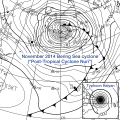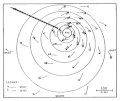Portal:Tropical cyclones
The Tropical Cyclones Portal
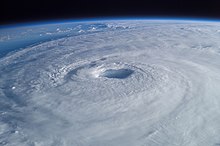
A tropical cyclone is a storm system characterized by a large low-pressure center, a closed low-level circulation and a spiral arrangement of numerous thunderstorms that produce strong winds and heavy rainfall. Tropical cyclones feed on the heat released when moist air rises, resulting in condensation of water vapor contained in the moist air. They are fueled by a different heat mechanism than other cyclonic windstorms such as Nor'easters, European windstorms and polar lows, leading to their classification as "warm core" storm systems. Most tropical cyclones originate in the doldrums, approximately ten degrees from the Equator.
The term "tropical" refers to both the geographic origin of these systems, which form almost exclusively in tropical regions of the globe, as well as to their formation in maritime tropical air masses. The term "cyclone" refers to such storms' cyclonic nature, with anticlockwise rotation in the Northern Hemisphere and clockwise rotation in the Southern Hemisphere. Depending on its location and intensity, a tropical cyclone may be referred to by names such as "hurricane", "typhoon", "tropical storm", "cyclonic storm", "tropical depression" or simply "cyclone".
Types of cyclone: 1. A "Typhoon" is a tropical cyclone located in the North-west Pacific Ocean which has the most cyclonic activity and storms occur year-round. 2. A "Hurricane" is also a tropical cyclone located at the North Atlantic Ocean or North-east Pacific Ocean which have an average storm activity and storms typically form between May 15 and November 30. 3. A "Cyclone" is a tropical cyclone that occurs in the South Pacific and Indian Oceans.
Selected named cyclone -

Racer's hurricane was a destructive tropical cyclone that had severe effects in northeastern Mexico, the Republic of Texas, and the Gulf Coast of the United States in early October 1837. It was named after the Royal Navy ship HMS Racer, which encountered the cyclone in the northwestern Caribbean. Termed "one of the most famous and destructive hurricanes of the century" by meteorology historian David Ludlum, the storm first affected Jamaica with flooding rainfall and strong winds on September 26 and 27, before entering the Gulf of Mexico by October 1. As the hurricane struck northern Tamaulipas and southern Texas, it slowed to a crawl and turned sharply northeastward. The storm battered the Gulf Coast from Texas to the Florida Panhandle between October 3 and 7. After crossing the Southeastern United States, it emerged into the Atlantic shipping lanes off the Carolinas by October 9.
The effects of the tropical cyclone were far-reaching. Matamoros, on the southern bank of the Rio Grande, faced hurricane conditions for several days, with significant damage to ships. Many towns along the Texas shoreline were inundated by storm surge, which flooded the coastal plains for many miles inland. Galveston Island was devastated, with nearly every building washed away and most vessels driven ashore. To the east, a water level rise of 8 ft (2.4 m) on Lake Pontchartrain submerged low-lying areas of New Orleans. Many steamboats on the lake were wrecked and buildings along its shores demolished. Storm surge and wind damage extended into Mississippi and Alabama, but with less severity. In the interior Southeast, sugar cane and cotton crops bore heavy losses. As the weakening storm buffeted the Outer Banks of North Carolina on October 9, the passenger steamship SS Home ran aground about 300 ft (91 m) off Cape Hatteras and rapidly broke up in the pounding surf. About 90 passengers and crewmen died in the wreck. Overall, Racer's hurricane killed an estimated 105 people. (Full article...)
Selected article -
Hurricane Wilma significantly affected the Yucatán Peninsula, bringing destruction to the area. Hurricane Wilma developed on 15 October in the Caribbean. Four days later, it intensified into the strongest Atlantic hurricane on record as determined by barometric pressure. Wilma weakened as it moved slowly northwestward, eventually making landfall late on 21 October on the island of Cozumel. At the time, it was a Category 4 hurricane on the Saffir–Simpson scale. Early the next day, the hurricane made another landfall on the Mexican mainland near Puerto Morelos. Wilma exited the Yucatán Peninsula into the Gulf of Mexico on 23 October.
The large and powerful hurricane dropped torrential rainfall across the northeastern Yucatán Peninsula and on offshore islands. Over a 24-hour period, Wilma produced 1,633.98 mm (64.330 in) of rainfall, the greatest 24-hour accumulation ever recorded in the Western Hemisphere. Parts of the Yucatán Peninsula experienced tropical storm-force winds for nearly 50 hours. An anemometer recorded a reading of 212 km/h (132 mph) before the instrument failed. The hurricane moved ashore with an estimated 4.6 m (15 ft) storm surge, accompanied by 5 to 8 m (16 to 26 ft) waves which reached the third stories of some buildings. Wilma severely eroded the beaches of eastern Quintana Roo and caused flooding in neighboring Yucatán. (Full article...)
Selected image -

Selected season -

The 2017 Atlantic hurricane season was a devastating and extremely active Atlantic hurricane season that became the costliest on record, with a damage total of at least $294.92 billion (USD). The season featured 17 named storms, 10 hurricanes, and 6 major hurricanes. Most of the season's damage was due to hurricanes Harvey, Irma, and Maria. Another notable hurricane, Nate, was the worst natural disaster in Costa Rican history. These four storm names were retired following the season due to the number of deaths and amount of damage they caused. Collectively, the tropical cyclones were responsible for at least 3,364 deaths. The season also had the highest accumulated cyclone energy (ACE) since 2005 with an approximate index of 224 units, with a record three hurricanes each generating an ACE of over 40: Irma, Jose, and Maria. This season featured two Category 5 hurricanes (one of only eight on record to feature multiple Category 5 hurricanes), and the only season other than 2007 with two hurricanes making landfall at that intensity. The season's ten hurricanes occurred one after the other, the greatest number of consecutive hurricanes in the satellite era, and tied for the highest number of consecutive hurricanes ever observed in the Atlantic basin.
The season officially began on June 1 and ended on November 30. These dates historically describe the period of year when most tropical cyclones form in the Atlantic basin and are adopted by convention. However, as shown by Tropical Storm Arlene in April, the formation of tropical cyclones was possible at other times of the year. In late August, Hurricane Harvey struck Texas and became the first major hurricane to make landfall in the United States since Wilma in 2005, ending the 12-year U.S. Major Hurricane drought and the strongest since Charley in 2004. The storm tied the record for the costliest tropical cyclone and broke the record for most rainfall dropped by a tropical cyclone in the United States, with extreme flooding in the Houston area. In early September, Hurricane Irma became the first Category 5 hurricane to impact the northern Leeward Islands on record, later making landfall in the Florida Keys as a Category 4 hurricane. In terms of sustained winds, Irma, at the time, became the strongest hurricane ever recorded in the Atlantic basin outside of the Gulf of Mexico and Caribbean, with maximum sustained winds of 180 mph (285 km/h); it was later surpassed in 2019 by Hurricane Dorian. In mid September, Hurricane Maria became the first Category 5 hurricane in history to strike the island of Dominica. It later made landfall in Puerto Rico as a high-end Category 4 hurricane with catastrophic effect. Most of the deaths from this season occurred from Maria. In early October, Hurricane Nate became the fastest-moving tropical cyclone in the Gulf of Mexico on record and the third hurricane to strike the contiguous United States in 2017. Slightly over a week later, Hurricane Ophelia became the easternmost major hurricane in the Atlantic basin on record, and later impacted most of northern Europe as an extratropical cyclone. The season concluded with Tropical Storm Rina, which became extratropical on November 9. (Full article...)
Related portals
Currently active tropical cyclones

Italicized basins are unofficial.
- North Atlantic (2025)
- No active systems
- East and Central Pacific (2025)
- No active systems
- West Pacific (2025)
- No active systems
- North Indian Ocean (2025)
- No active systems
- Mediterranean (2024–25)
- No active systems
- South-West Indian Ocean (2024–25)
- No active systems
- Australian region (2024–25)
- No active systems
- South Pacific (2024–25)
- No active systems
- South Atlantic (2024–25)
- No active systems
Last updated: 12:08, 5 January 2025 (UTC)
Tropical cyclone anniversaries
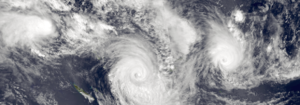
January 7
- 1966 - Cyclone Denise struck Réunion, producing 1,825 mm (71.9 in) of rainfall at Foc-Foc. This is the highest 24 hour rainfall total worldwide.
- 1998 - Three cyclones (pictured) – Ron (right), Susan (center), and Katrina (left) – are active over the southern Pacific Ocean. The former two were among the strongest on record for the region, while the latter lasted 24 days while moving erratically around Australia.

January 8
- 1979 - Typhoon Alice (pictured) reached its peak with 215 km/h (130 mph) winds in the open Pacific Ocean. Alice caused extensive damage in the Marshall Islands.
- 2010 - Cyclone Edzani became a very intense tropical cyclone, the first in the basin in five years.

January 9
- 1880 - An unnamed tropical cyclone struck land near Onslow, Western Australia. The storm created an 8‑metre (26‑ft) storm tide and sank the ship Adalia, drowning some of the crew.
- 2006 - Cyclone Clare (pictured) struck Pilbara, Western Australia, causing heavy rainfall but minor damage.
Did you know…
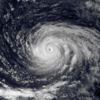



- …that the Joint Typhoon Warning Center considers that Typhoon Vera (pictured) of 1986 is actually two distinct systems, formed from two separated low-level circulations?
- …that Cyclone Freddy (track pictured) in 2023 was the longest-lasting tropical cyclone recorded?
- …that the typhoons of 2024—Yinxing, Toraji, Usagi, and Man-yi (pictured)—made history as the first recorded instance since 1951 of four tropical cyclones coexisting in November?
- …that Hurricane Otis (pictured) in 2023 was the first Pacific hurricane to make landfall at Category 5 intensity and surpassed Hurricane Patricia as the strongest landfalling Pacific hurricane on record?
General images -

The 1990–91 South Pacific cyclone season was a below-average season; only two tropical cyclones occurred within the South Pacific to the east of 160°E. The season officially ran from November 1, 1990, to April 30, 1991, but the first disturbance of the season formed on November 23 and the last dissipated on May 19. This is the period of the year when most tropical cyclones form within the South Pacific Ocean. During the season, no one was killed from tropical disturbances within the South Pacific. However, six people were killed by Cyclone Joy when it made landfall on Australia. The only tropical cyclone to cause any damage while within this basin was Sina, which caused at least $18.5 million (1991 USD) worth of damage to Fiji and Tonga. As a result of the impacts of both Joy and Sina, the names were retired from the tropical cyclone naming lists.
Within the South Pacific, tropical cyclones were monitored by the Tropical Cyclone Warning Centers (TCWC) at the Fiji Meteorological Service in Nadi and by the Meteorological Service of New Zealand Limited in Wellington. Tropical cyclones that moved to the west of 160°E were monitored as a part of the Australian region by the Australian Bureau of Meteorology. Both the United States Joint Typhoon Warning Center (JTWC) and the Naval Western Oceanography Center (NWOC) issued unofficial warnings within the southern Pacific. The JTWC issued warnings between 160°E and the International Date Line, while the NWOC issued warnings for tropical cyclones forming between the International Date Line and the coasts of the Americas. Both the JTWC and the NWOC-designated tropical cyclones with a number and a P suffix with numbers assigned in numerical order to tropical cyclones developing within the whole of the Southern Hemisphere. TCWC Nadi and TCWC Wellington both use the Australian Tropical Cyclone Intensity Scale, and measure windspeeds over ten minutes, while the JTWC and the NWOC measured sustained winds over one minute and use the Saffir–Simpson Hurricane Scale. (Full article...)
Topics
Subcategories
Related WikiProjects
WikiProject Tropical cyclones is the central point of coordination for Wikipedia's coverage of tropical cyclones. Feel free to help!
WikiProject Weather is the main center point of coordination for Wikipedia's coverage of meteorology in general, and the parent project of WikiProject Tropical cyclones. Three other branches of WikiProject Weather in particular share significant overlaps with WikiProject Tropical cyclones:
- The Non-tropical storms task force coordinates most of Wikipedia's coverage on extratropical cyclones, which tropical cyclones often transition into near the end of their lifespan.
- The Floods task force takes on the scope of flooding events all over the world, with rainfall from tropical cyclones a significant factor in many of them.
- WikiProject Severe weather documents the effects of extreme weather such as tornadoes, which landfalling tropical cyclones can produce.
Things you can do
 |
Here are some tasks awaiting attention:
|
Wikimedia
The following Wikimedia Foundation sister projects provide more on this subject:
-
Commons
Free media repository -
Wikibooks
Free textbooks and manuals -
Wikidata
Free knowledge base -
Wikinews
Free-content news -
Wikiquote
Collection of quotations -
Wikisource
Free-content library -
Wikiversity
Free learning tools -
Wikivoyage
Free travel guide -
Wiktionary
Dictionary and thesaurus








